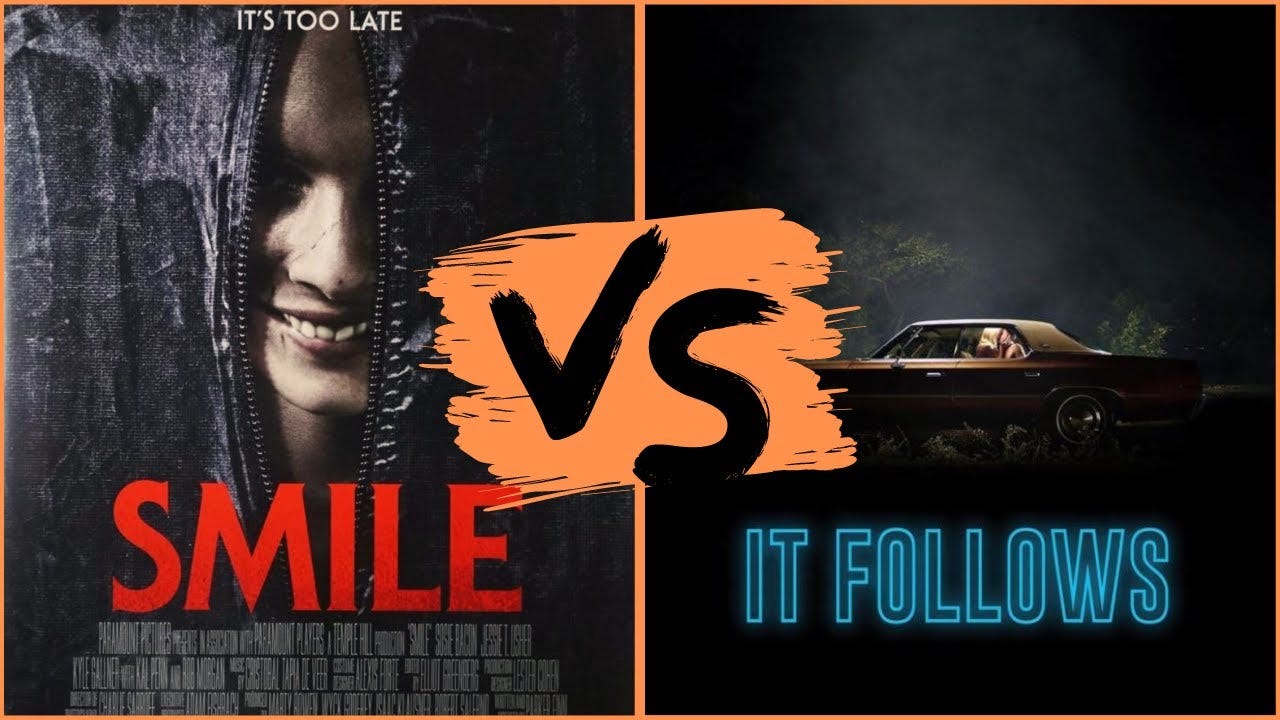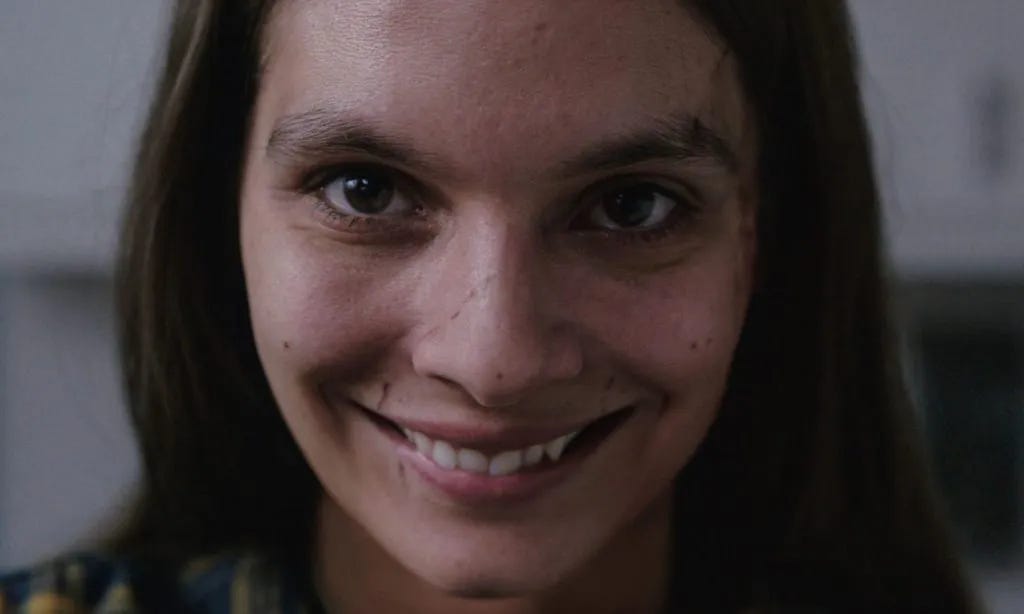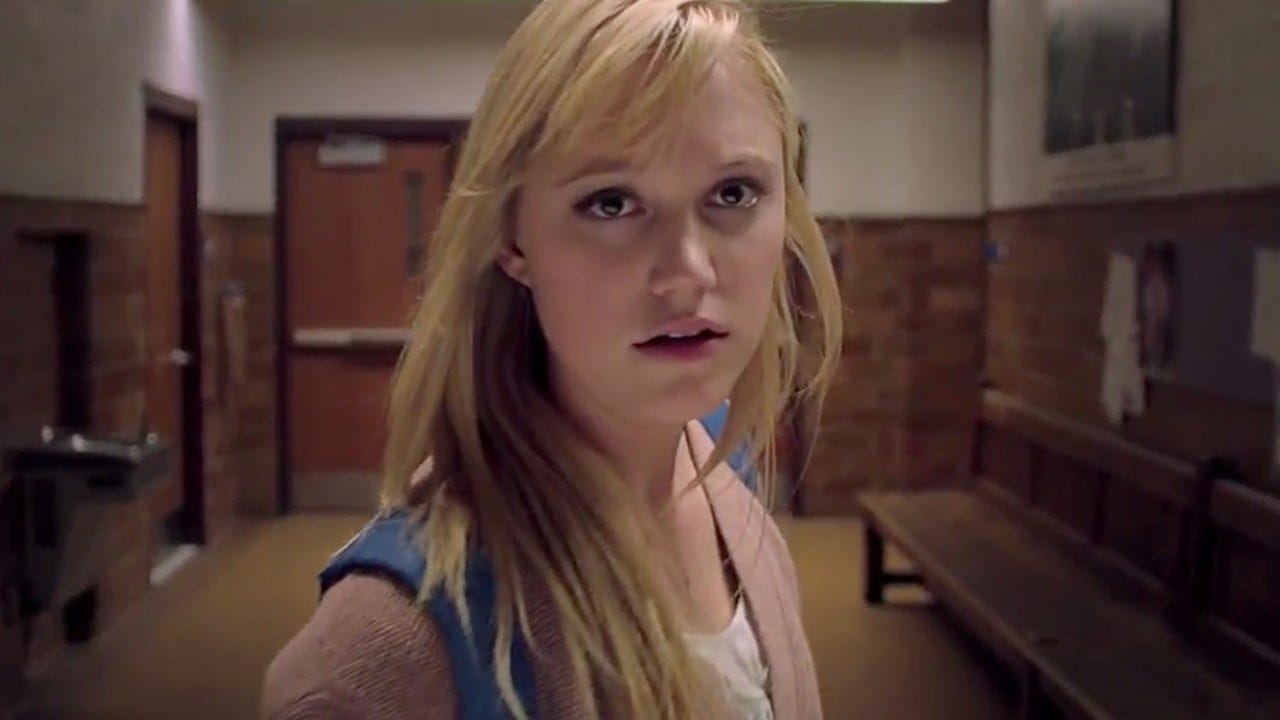FILM COMPARISONS PART ONE: 2014's It Follows and 2022's Smile
Trauma Horror Movie Analysis. By Carlos J. Gonzalez
Disclaimer: Before diving in, I want to clarify that this is not a comparison of the quality of Smile and It Follows (2014). Instead, I’m examining their thematic similarities—how both films use trauma, mental illness, social dynamics, and even bleak inevitability to create existential horror. While each takes a different approach, both tell stories about forces that latch onto their victims, feeding on fear and despair, making survival feel like an impossible task.
I first experienced Parker Finn’s Smile (2022), an expansion of his 2020 short film Laura Hasn’t Slept on Amazon Prime back in 2023. Despite its use of familiar horror tropes—such as the evil smile that curls on a person’s face signifying some kind of malevolence or horrible act about to occur or has occurred, the film was masterfully unnerving from start to finish. It wasn’t just the jump scares or the sinister grins—it was the oppressive sense of dread, the way trauma manifested as something inescapable. It had become somewhat of a phenomenon and spawned a successful franchise with the success of Smile 2 (2024) which went on to big box-office and accolades for its star—Naomi Scott; a pop singer who also begets the smiley entity curse before starting a comeback world tour.
I didn’t see It Follows up until recently though I had known for some time that many compared Finn’s film to writer/director David Robert Mitchell’s moody, allegorical elevated horror film about a curse passed on through sexual intercourse. Despite another comparison to a previous 2018 movie called Truth or Dare, that Blumhouse produced—that bore a similar premise, I’m going to stick to the visions that Mitchell and Finn had for their respective films.
Supernatural Horror as a Metaphor for Trauma
Both films use the supernatural as a conduit for deeper, real-world fears. In Smile, the entity serves as an allegory for mental illness—an inherited, contagious force that preys on unresolved trauma. It Follows on the other hand, frames its horror through the consequences of casual sex, with its shape-shifting curse acting as a relentless metaphor for guilt, shame, or even sexually transmitted infections—and in the far-reaching scope, the effect of abortion?
In both cases, the entity is more than just a monster—it’s a manifestation of something deeply psychological, forcing the heroines, Dr. Rose Cotter (played by Sosie Bacon—Kevin Bacon’s daughter) and teenager Jay (played by Maika Monroe), to confront their respective traumas. They are given two choices: fight back against an unstoppable force or succumb to it entirely. The question is never just survival—it’s whether they can escape the weight of their own suffering before it consumes them.
Caitlyn Stacy as Laura Weaver in 2022’s Smile - Paramount Pictures.
The Atmosphere of Dread: Psychological Horror vs. Moral Ambiguity
Parker Finn crafts a relentless atmosphere of tension and paranoia in Smile, forcing both Dr. Cotter and the audience to question their own sanity. The entity's psychological torment echoes symptoms of severe schizophrenia or severe trauma, making it unclear whether Rose is being haunted or spiraling into mental decline. This uncertainty amplifies the horror—how do you fight something that might only exist in your mind?
Meanwhile, It Follows takes a more ambiguous approach. Jay's visions—often appearing as eerie, slow-moving corpses—suggest multiple interpretations. Is the entity a manifestation of guilt over casual sex? A metaphor for sexually transmitted infections? Or perhaps a subconscious reckoning with the fear of pregnancy or abortion? Writer/director David Robert Mitchell never gives a definitive answer, instead allowing the film’s moral ambiguity to tease both Jay and the audience. This vagueness makes It Follows more unsettling, as its horror isn't just supernatural—it’s existential.
Can These Entities Be Stopped?
Some spoilers ahead—so best to watch both films. Just as with real-world mental illness and deep-seated trauma, Smile doesn’t offer Rose the promise of a happy ending. Even after she confronts her past, the entity remains relentless, revealing its true form—an eerie, sinewy, neuromuscular creature with grotesque teeth that shape-shifts before forcing its way inside her. The film leaves an unsettling question: Is this entity truly unstoppable? Can it ever be killed, or does it feed endlessly on suffering, making survival a temporary illusion?
Maika Monroe as Jay in It Follows. Northern Lights Films.
It Follows takes a different approach, offering potential solutions—however morally dubious they may be. The curse can be “passed on” through sex, placing the burden onto another person, or as seen in the film’s swimming pool climax, it can be confronted directly. The infamous pool scene is a prime example of this: rather than surrender, Jay and her friends attempt to outsmart the entity, fighting it as a collective force. Whether or not it truly dies remains ambiguous, but the film suggests that survival isn’t just about individual endurance—it’s about shared resilience and facing trauma together.
Conclusion
While the similarities between Smile and It Follows are evident, it’s refreshing to see elevated horror films tackle these themes head-on. Other elevated horror films like The Babadook, Midsommar and The Menu, also use trauma as a story arc to various degrees of success or fail—but Smile and It Follows seamlessly blend grounded reality with the supernatural to create something more terrifying. Both films don’t just hint at the presence of their entities—they force us to witness their effects and the lasting damage they inflict. Whether through Smile’s relentless psychological terror or It Follows’ eerie, slow-burn inevitability, these films challenge us to confront trauma, fear, and the horrifying question: Can we ever truly escape what haunts us?
In future articles, I’ll continue exploring the deeper themes, tones, ideas, characters, and resolutions of horror films, drawing connections between them and uncovering the vast similarities that make the genre so powerful. Thanks for reading.






